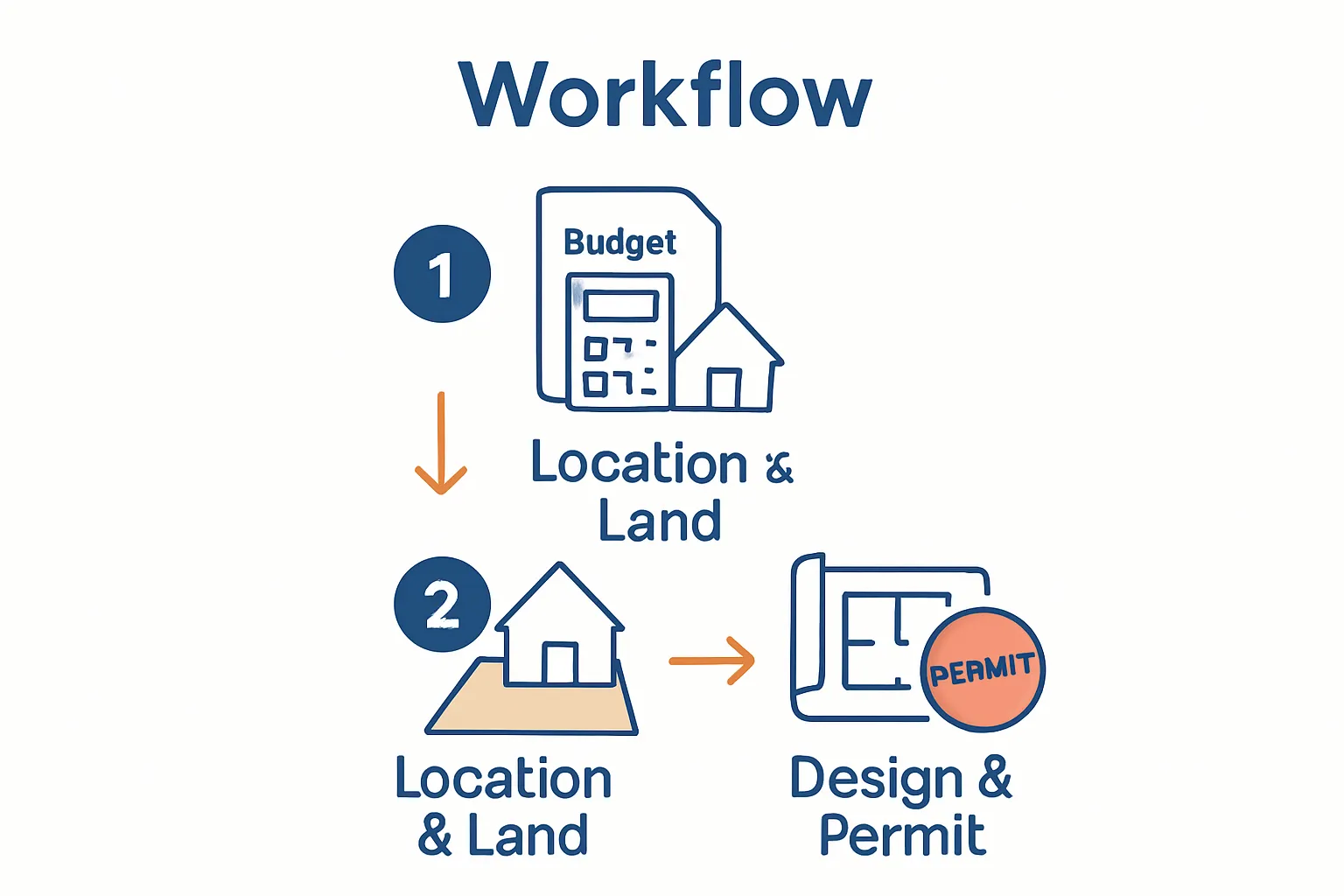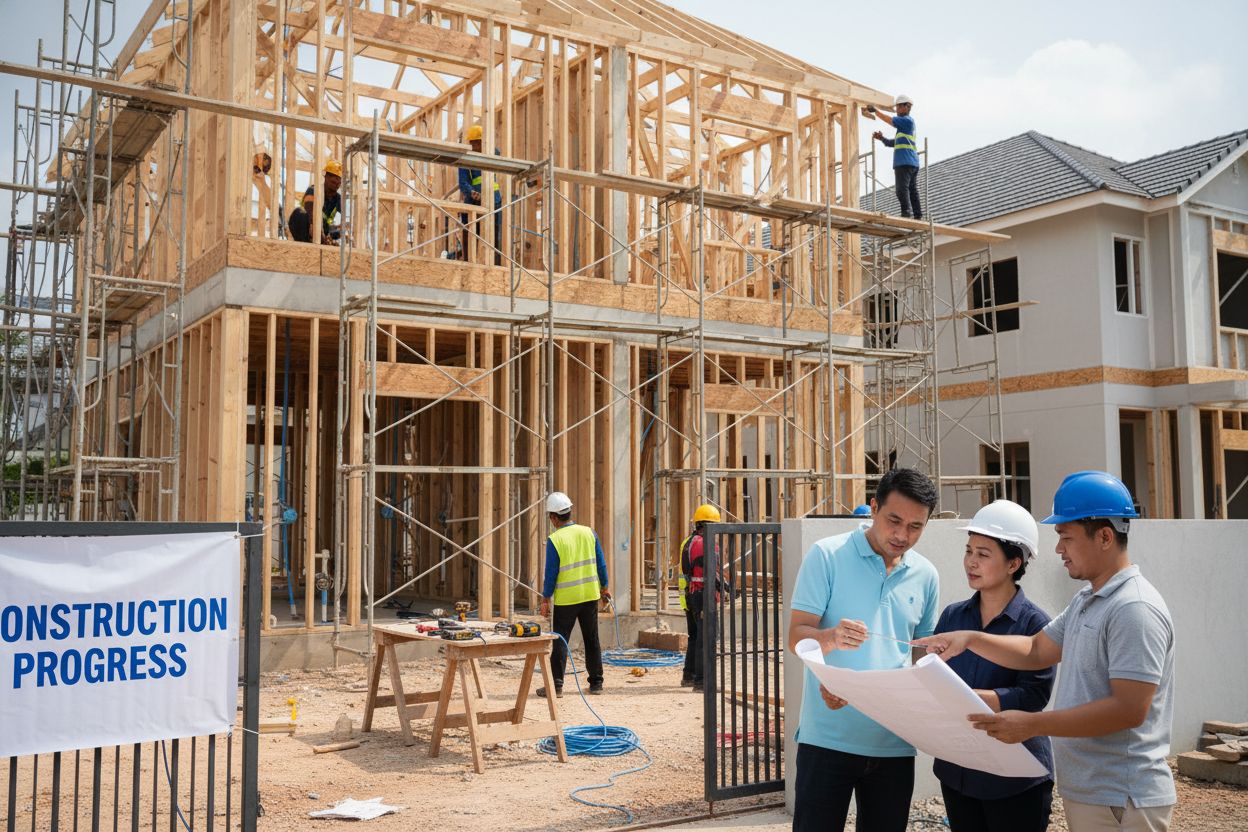Building your own home in Malaysia is often seen as a lifetime milestone and a symbol of hard-earned success. Yet, despite the excitement, nearly 30 percent of new homeowners underestimate costs within the first year of breaking ground. Most people assume the construction journey is all about architectural plans and glossy finishes, but the truth is your project’s fate is usually sealed long before the first brick is even laid. The difference lies in how you tackle the early financial and planning steps—setting the stage for everything that follows.
Table of Contents
- Step 1: Assess Your Budget And Financial Options
- Step 2: Choose A Suitable Location And Land
- Step 3: Design Your Home And Obtain Necessary Permits
- Step 4: Hire A Reliable Contractor And Builder
- Step 5: Oversee Construction Progress And Quality Checks
- Step 6: Finalize Inspections And Move In
Quick Summary
| Key Point | Explanation |
|---|---|
| 1. Assess your full financial picture | Determine your available capital through thorough evaluation of savings, loans, and investments to inform your home-building budget. |
| 2. Prioritise location and site assessment | Evaluate accessibility, infrastructure quality, zoning laws, and geological stability to optimise your home’s value and future growth. |
| 3. Engage a qualified architect for design | Collaborate with a professional to create practical, adaptable designs while ensuring compliance with local building regulations. |
| 4. Select a trustworthy contractor | Research potential contractors thoroughly, focusing on their experience, credentials, and ability to communicate effectively. |
| 5. Conduct thorough final inspections | Ensure structural integrity and legal compliance by securing independent evaluations and necessary documentation before moving in. |
Step 1: Assess Your Budget and Financial Options
Building a new home represents a significant financial commitment that requires meticulous planning and strategic financial management. Your initial step involves comprehensive budget assessment and exploring various financial pathways to transform your residential dream into reality. Understanding your financial landscape will determine the scope, scale, and potential success of your home construction project.

Begin by conducting a thorough evaluation of your current financial standing. Calculate your total available capital, including savings, potential loans, and investment resources. Recommended financial documentation to gather includes:
- Personal bank statements from past 12 months
- Income verification documents
- Existing loan statements
- Investment portfolio details
Consider consulting a financial advisor who specializes in residential construction financing. These professionals can provide nuanced insights into managing construction costs and navigating complex financial products specific to home building. According to Malaysia’s Housing Financing Guide, understanding mortgage options and construction loan structures is crucial for successful project planning.
Your budget assessment should encompass not just construction costs, but also additional expenses such as land acquisition, permits, architectural design, utility connections, and potential landscaping. Many homeowners underestimate these peripheral expenses, which can significantly impact overall project feasibility. Create a comprehensive spreadsheet detailing estimated costs for each project phase, allowing flexibility for unexpected expenditures.
Below is a checklist table to help you prepare the essential documents and requirements for budgeting and financing your new home construction project.
| Requirement | Purpose | Notes |
|---|---|---|
| Personal bank statements (12 months) | Verify savings and spending habits | Required by most lenders |
| Income verification documents | Demonstrate financial capability | Include salary slips/tax returns |
| Existing loan statements | Assess outstanding debt obligations | All current loan accounts |
| Investment portfolio details | Evaluate available financial resources | Shares, unit trusts, etc. |
| Financial advisor consultation | Gain professional insight into funding options | Specialist in construction loans |
| Budget spreadsheet | Track estimated costs and projected spending | Allow flexibility for contingencies |
| Contingency fund (10-15% of budget) | Prepare for unexpected project expenses | Buffer for unforeseen costs |
Explore multiple financing mechanisms tailored to home construction in Malaysia. Government schemes like LPPSA, KWSP, and KMMB offer specialized financing options that can provide more favorable terms compared to traditional bank loans. These programmes often feature lower interest rates and extended repayment schedules specifically designed for residential construction projects.
Here is a comparison table summarising common government-backed financing options for home construction in Malaysia, to support your budget planning.
| Financing Scheme | Provider | Key Features | Typical Benefits |
|---|---|---|---|
| LPPSA | Government | Designed for civil servants | Lower rates, flexible repayment |
| KWSP | EPF (KWSP) | Withdraw from EPF account | No interest, uses own savings |
| KMMB | Ministry/Agency | Targeted home construction loans | Extended repayment, low interest |
| Traditional Bank | Commercial banks | Standard construction financing | Widely available, varied products |
Finally, establish a robust financial buffer by allocating approximately 10-15% of your total budget for contingencies. Construction projects invariably encounter unexpected challenges, and maintaining financial flexibility ensures your project remains viable even when confronted with unforeseen expenses. Your careful financial groundwork during this initial stage will set a solid foundation for a successful home building journey.
Step 2: Choose a Suitable Location and Land
Selecting the right location and land is a critical decision that will significantly impact your new home’s long-term value, comfort, and functionality. This step requires careful consideration of multiple factors beyond simple aesthetic appeal. Your chosen location will influence everything from daily living experiences to potential future property appreciation.
explore comprehensive land selection strategies with meticulous research and strategic evaluation. Begin by mapping out your priority requirements, which extend far beyond just geographical coordinates. Consider proximity to essential infrastructure such as public transportation, healthcare facilities, schools, and commercial centers. Critical location assessment criteria include:
- Accessibility to main roads and highways
- Proximity to workplace and family networks
- Quality of local infrastructure and utilities
- Future development potential of the surrounding area
Understand local zoning regulations and land use restrictions before making any financial commitments. Municipal planning documents provide crucial insights into permissible construction types, potential future developments, and any environmental constraints. According to Malaysian Urban and Regional Planning Department Guidelines, each region has specific land use regulations that can dramatically affect your construction plans.
Geological assessments represent another vital component of land selection. Engage professional surveyors to evaluate soil composition, drainage capabilities, ground stability, and potential environmental risks. These technical evaluations prevent expensive construction complications and ensure your home’s structural integrity. Some regions in Malaysia have complex geological characteristics that require specialized foundation designs, making expert consultation indispensable.
Financial considerations should also guide your location selection. Research comparative land values in different neighborhoods, understanding how location impacts potential property appreciation. Some emerging suburban areas offer more competitive pricing while maintaining excellent future growth potential. Your goal is finding a balance between current affordability and long-term investment potential.
Conduct thorough site visits at different times of day and under varying weather conditions. This practical approach reveals nuanced characteristics such as noise levels, traffic patterns, natural lighting, and potential environmental challenges. Personal observation complements technical assessments, providing a holistic understanding of your prospective land’s suitability for your dream home.
Step 3: Design Your Home and Obtain Necessary Permits
Designing your home represents a pivotal moment where your vision transforms from abstract concept to tangible blueprint. This critical stage demands meticulous planning, creative thinking, and comprehensive understanding of regulatory requirements. Your design process will determine not just aesthetic appeal, but functional livability and legal compliance.
discover professional design strategies that balance personal preferences with practical constraints. Begin by engaging an experienced architect who understands local building codes and can translate your lifestyle needs into architectural reality. Key design considerations include:
- Spatial flow and room interconnectivity
- Natural lighting and ventilation requirements
- Future adaptability of living spaces
- Energy efficiency potential
Navigate the complex permit acquisition process by first understanding municipal regulations specific to residential construction. According to Malaysian Urban Planning Guidelines, different regions have unique approval processes requiring precise documentation. Prepare comprehensive architectural plans that demonstrate compliance with local zoning laws, building height restrictions, setback requirements, and environmental regulations.
Your architectural design should prioritize both immediate functionality and long-term adaptability. Consider potential future needs such as family expansion, home office integration, or accessibility modifications. Professional architects can help create flexible spaces that evolve with changing lifestyle requirements, preventing costly renovations later.
Permit acquisition involves multiple government departments, including local municipalities, utility providers, and environmental agencies. Compile a thorough documentation package including detailed site plans, architectural drawings, environmental impact assessments, and proof of land ownership. Anticipate potential review cycles and allocate sufficient time for bureaucratic processes, which can typically range from three to six months depending on local jurisdiction complexity.
Financial prudence demands careful cost estimation during the design phase. Work closely with your architect to develop realistic budget projections, incorporating potential contingencies for unexpected design modifications or regulatory requirements. A well-structured design not only meets legal standards but also optimizes construction efficiency, potentially reducing overall project expenditure.
Step 4: Hire a Reliable Contractor and Builder
Selecting the right contractor represents a pivotal decision that can make or break your entire home construction project. This step demands rigorous evaluation, strategic thinking, and a comprehensive understanding of professional construction capabilities. Your chosen contractor will be responsible for transforming architectural blueprints into physical reality, making their expertise and reliability paramount.
discover essential contractor selection strategies that ensure successful project execution. Begin by conducting thorough background research, examining each potential contractor’s professional credentials, past project portfolios, and industry reputation. Critical contractor evaluation criteria include:
- Valid professional licensing and certifications
- Demonstrated experience in similar residential projects
- Robust financial stability and business track record
- Positive client testimonials and references
Understand that contractor selection extends beyond mere cost comparisons. According to Malaysian Construction Industry Development Board Guidelines, professional contractors must demonstrate comprehensive project management capabilities, technical competence, and adherence to national building standards. Request detailed project proposals that outline precise work schedules, material specifications, quality assurance mechanisms, and transparent cost breakdowns.
During initial consultations, assess potential contractors communication skills and professional approach. A reliable contractor should provide clear, detailed explanations, demonstrate active listening, and show genuine interest in understanding your specific project requirements. Pay attention to their responsiveness, willingness to address concerns, and ability to provide practical solutions to potential construction challenges.
Legal documentation represents another crucial aspect of contractor engagement. Develop a comprehensive written contract that explicitly outlines project scope, payment schedules, performance expectations, and dispute resolution mechanisms. Ensure the contract includes specific clauses addressing potential project variations, timeline extensions, and quality standards. Professional contractors will welcome transparent contractual arrangements that protect both parties interests.
Finally, establish a robust communication framework that facilitates regular project updates and collaborative problem solving. Schedule periodic project review meetings, maintain open communication channels, and create mechanisms for addressing unexpected challenges promptly and efficiently. Your proactive engagement will foster a collaborative relationship essential for successful home construction.
Step 5: Oversee Construction Progress and Quality Checks
Construction oversight represents a critical phase where your active involvement transforms theoretical plans into physical reality. This stage demands consistent engagement, technical understanding, and proactive quality management. Your role transitions from passive observer to strategic project guardian, ensuring every construction element meets predetermined standards and aligns with original design specifications.
explore comprehensive construction monitoring techniques that safeguard your investment. Establish a systematic approach to tracking construction progress, implementing regular site inspections and maintaining detailed documentation. Essential monitoring priorities include:
- Structural integrity verification
- Material quality assessment
- Compliance with architectural blueprints
- Adherence to approved timeline
Consistent communication with your contractor forms the backbone of effective project management. According to Malaysian Construction Industry Standards, successful projects rely on transparent, frequent interactions between homeowners and construction teams. Schedule weekly site meetings to review progress, discuss potential challenges, and confirm that each construction phase meets technical and aesthetic expectations.

Technical quality checks require systematic documentation and professional expertise. Consider engaging independent building inspectors who can provide unbiased assessments at critical construction stages. These professionals can identify potential structural issues, material deficiencies, or deviation from original design plans before they become expensive remediation challenges.
Financial prudence demands linking progress payments to specific, verifiable construction milestones. Create a structured payment schedule that incentivizes timely, high-quality work while protecting your financial interests. Each payment should correspond with completed project stages, accompanied by comprehensive documentation demonstrating successful completion of predetermined quality standards.
Maintain a comprehensive project logbook documenting every site visit, conversation, decision, and potential deviation from original plans. This meticulous record serves multiple purposes: legal protection, financial tracking, and providing a clear narrative of your home construction journey. Your proactive approach transforms construction oversight from a passive responsibility into a strategic partnership ensuring your dream home becomes a tangible, high-quality reality.
Step 6: Finalize Inspections and Move In
The final stage of home construction represents a culmination of months of strategic planning, careful execution, and significant investment. This critical phase transforms your meticulously designed project from a construction site into a livable home, requiring comprehensive final inspections, legal certifications, and systematic move-in preparation. Your attention to detail during these concluding steps ensures a smooth transition and protects your substantial investment.
The table below condenses key elements to verify during your final construction inspection, along with their purposes and tips for ensuring a smooth move-in.
| Inspection Element | Purpose | Tips for Homeowners |
|---|---|---|
| Structural integrity check | Ensure building is safe and stable | Use independent inspector |
| Electrical and plumbing systems | Confirm full functionality and safety compliance | Test all fixtures and outlets |
| Documentation review | Verify all legal and regulatory permits are in place | Store digital and physical copies |
| Municipal final certification | Gain official confirmation of occupancy eligibility | Secure multiple copies for records |
| Utility activation | Guarantee readiness of electricity, water, internet | Arrange before move-in day |
| Final cleaning | Prepare a fresh, liveable environment | Consider professional service |
| Defect list creation | Record any remaining issues for timely resolution | Set timeline with the contractor |
discover comprehensive home handover strategies that guarantee a seamless completion process. Initiate a thorough, multi-stage inspection protocol that goes beyond superficial assessments. Critical final inspection elements include:
- Comprehensive structural integrity verification
- Electrical and plumbing system functionality tests
- Comprehensive documentation review
- Final certification from municipal authorities
Engage professional building inspectors who can provide an independent, comprehensive evaluation of your new home. According to Malaysian Construction Industry Development Board Guidelines, final inspections must cover structural integrity, safety standards, and compliance with original architectural plans. Request detailed inspection reports documenting every assessed component, creating a definitive record of your home’s condition at handover.
Legal documentation represents another crucial aspect of project completion. Verify that all necessary permits, certificates of completion, and occupancy approvals have been secured from relevant municipal authorities. This documentation protects your legal rights and ensures your new home meets all regulatory requirements. Retain multiple copies of these critical documents in secure, easily accessible locations.
Prepare a systematic move-in strategy that minimizes potential disruptions. Create a comprehensive checklist addressing utilities connection, initial cleaning, and essential furnishing requirements. Schedule utility activations in advance, ensuring electricity, water, internet, and other critical services are operational before your move-in date. Consider professional cleaning services to prepare the space, and plan initial furniture placement to streamline your transition.
Finally, document any identified defects or required minor corrections during the final inspection. Establish a clear timeline with your contractor for addressing these items, ensuring they are resolved promptly and to your satisfaction. Your proactive approach during this final stage transforms your construction project from a theoretical plan into a tangible, comfortable living space, marking the successful conclusion of your home-building journey.
Take Charge of Your Home Building Journey with RumahHQ
Are you feeling overwhelmed by all the complex steps involved in building a new home? From evaluating your budget to finding reliable contractors, every phase comes with its own hurdles. With unpredictable costs, complicated permits, and the risk of hidden construction issues, it’s easy to feel lost or anxious about turning your dream home into reality.

Let RumahHQ be your trusted partner in this journey. We offer expert guidance through every essential phase outlined in this article. Experience full transparency with fixed-price packages, free design consultations, and a professional team that handles legal approvals and construction management efficiently. Access special financing options like LPPSA and KWSP to make your new build affordable and stress-free. Do not let uncertainty hold your project back—visit RumahHQ’s main platform to explore our step-by-step building process or learn more about how a professional designer can transform your next project on our interior design strategies page. Take the first step towards a quality home that exceeds your expectations right now.
Frequently Asked Questions
What is the first step in building a new home?
The first step in building a new home is to assess your budget and financial options. This involves evaluating your current financial standing, exploring various funding pathways, and understanding all costs associated with the construction project.
How do I choose the right location for my new home?
Choosing the right location involves considering factors such as accessibility to main roads, proximity to essential services, local infrastructure quality, and future development potential of the area. Conduct thorough research and site visits to evaluate potential locations.
What should I consider when designing my home?
When designing your home, key considerations include spatial flow, natural light and ventilation, energy efficiency, and future adaptability of spaces. It’s advisable to engage an experienced architect who can align your preferences with practical constraints and local building codes.
How can I ensure that my construction project is on schedule and within budget?
To ensure your construction project remains on schedule and within budget, maintain regular communication with your contractor, implement a systematic monitoring approach, and link progress payments to verifiable milestones. Additionally, document every aspect of the project for transparency and accountability.
Recommended
- 7 Langkah Mudah untuk Bina Rumah Idaman di Atas Tanah Sendiri di Selangor (Panduan Lengkap!) | RumahHQ – Kontraktor Bina & Renovate Rumah
- 8 Nasihat Emas untuk Merealisasikan Impian Rumah Idaman di Atas Tanah Sendiri – Jangan Buat Silap! | RumahHQ – Kontraktor Bina & Renovate Rumah
- 8 Rahsia Rumah Tahan Gempa Yang Ramai Tak Tahu! Jangan Sampai Rumah Jadi Runtuh Macam Biskut Marie! | RumahHQ – Kontraktor Bina & Renovate Rumah
- 8 Tip Genius untuk Memaksimumkan Ruang dalam Rumah Kecil Anda! | RumahHQ – Kontraktor Bina & Renovate Rumah







